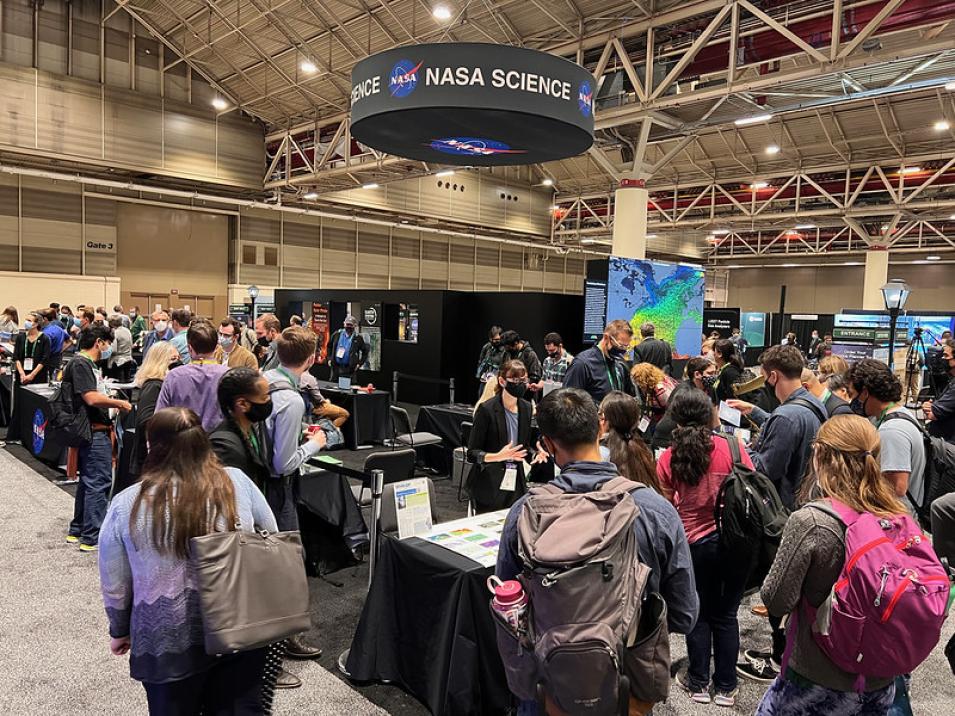Members of NASA’s Earth Science Data Systems (ESDS) Program will be in the Windy City—Chicago, Illinois—for the American Geophysical Union (AGU) Fall Meeting, December 12-16. ESDS components, including the Earth Science Data and Information System (ESDIS) Project, the Interagency Implementation and Advanced Concepts Team (IMPACT), the Commercial SmallSat Data Acquisition (CSDA) program, and the Earthdata Geographic Information Systems Team (EGIST), will share the latest developments in open-source science, cloud computing, and data discovery and access.
The theme of this year’s Fall Meeting—Science Leads the Future—is a perfect description of NASA Earth science accomplishments this past year and a tease of exciting events coming your way in 2023. Along with the planned December 15 early-morning launch of the groundbreaking Surface Water and Ocean Topography (SWOT) mission, NASA has designated 2023 the Year of Open Science. Numerous AGU presentations and events will show the benefits of providing data openly and without restriction in the many formats needed to advance our understanding of the planet.
The NASA Booth (#1937) in the McCormick Place convention center AGU Exhibit Hall will be a hub of activity and your opportunity to attend Hyperwall talks, find out about the latest NASA Earth science data from NASA Distributed Active Archive Center (DAAC) representatives, and, of course, get your free NASA calendar.
Whether you attend in person or online, here’s a small taste of NASA ESDS AGU activities. Please see the AGU Scientific Program and Schedule for all planned events and sessions.
2023: The Year of Open Science
NASA is designating 2023 as the Year of Open Science, a global community initiative to spark change and inspire open science engagement through events and activities designed to shift the current paradigm of how data are used and how science is conducted. Members from NASA’s Open-Source Science Initiative (OSSI) and Transform to Open Science (TOPS) teams have several events, including:
- Data and Open Science for Capable Communities and Scientific Discovery Town Hall
- Open Science Events, Curricula, and Opportunities Town Hall
- NASA Science Mission Directorate (SMD) Open-Source Science Initiative Town Hall
- The Future is Open Innovation Session
For more NASA open science oral sessions, posters, and events, search the AGU Science Program using “NASA Open Science.”
NASA Earth Science Data, Online Sessions, and the NASA Booth
ESDS and ESDIS AGU events— a mix of workshops, presentations, demonstrations, Hyperwall talks, and more — will inform attendees about NASA Earth Observing System Data and Information System (EOSDIS) data and services in the Earthdata Cloud and demonstrate new ways to analyze and work with these data. Throughout the meeting, participants will be able to connect with Earth science personnel virtually or in person to learn more about EOSDIS data products, services, and tools that enable data access, visualization, and analysis.
If you are attending virtually, online-only sessions by the ESDS Outreach Team include Engaging University Students with NASA Data to Analyze Earth System Phenomena, Data Pathfinders Help Make Time for Science, and Enabling Data Dexterity Among Students Using a NASA Data Pathfinder. Additionally, several online-only sessions will highlight IMPACT innovations, including sessions about context-based acronym recognition approach (CARA), convolutional neural networks (CNN), and NASA’s Science Discovery Engine (SDE).

